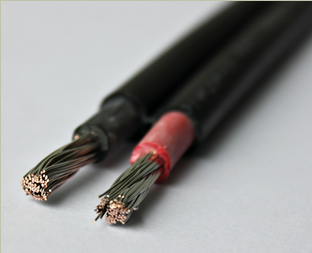
 Totline:021-57186991
Totline:021-57186991  Switchboard:0086-21-37100188
Switchboard:0086-21-37100188 

 Totline:021-57186991
Totline:021-57186991  Switchboard:0086-21-37100188
Switchboard:0086-21-37100188 
Solar energy technology will become one of the future green energy technologies. As the environment of photovoltaic power plants is more and more complicated, the requirements for photovoltaic cables are also increasing. If an ordinary cable is used, the sheath of the ordinary cable has poor ultraviolet protection performance, which leads to aging of the cable outer cable, thereby affecting the service life of the cable, which may cause problems such as cable short circuit, fire alarm or dangerous personnel injury. So what requirements do PV-specific cables need to meet?

First, the requirements of high and low temperature characteristics
Low temperature: The temperature in winter is low in the western and northern regions, and the low temperature in extreme regions can reach minus -40 °C. This requires a good low temperature resistance of the cable.
Withstand high temperatures: the surface temperature in the eastern and southern regions can easily reach above +70 °C, and the extreme temperature in areas with poor heat dissipation is likely to exceed +90 °C. This requires the material temperature of the cable to meet the requirements of the plant operating at extreme temperatures.
Second, the requirements of anti-humidity characteristics
Application environment: Many of the power plants in the fish-light complementary project are built directly on the fish pond or water surface, requiring the cable to work normally in a humid environment for a long time.
Frequent changes in temperature and humidity have a direct impact on the insulation of the material and the ageing of the sheath.
Special requirements: Consider the factors affecting the aging properties of insulation and sheath materials in the hot and humid environment. The insulation and sheath materials selected are at +90 ° C and 85% humidity.
Compliance with the standard: The test is carried out in accordance with the method specified in GB/T2423.3-2006. The tensile strength and elongation at break of the insulation and sheath are not more than 30% after the test.
Third, resistance to sunlight, ultraviolet light
Requirements: Many of the cables of the photovoltaic power station are barely laid. The solar modules to the combiner box and even the cables to the inverter are mostly barely laid. This requires the cable to withstand the radiation of sunlight and ultraviolet rays. Long-term normal operation under the vertical radiation of sunlight and ultraviolet rays.
Application environment: Qinghai, Tibet, Xinjiang, Gobi Desert and desert areas
Fourth, resistance to sunlight, ultraviolet light
Application environment: special areas such as seaside, beach, salt field
Special requirements: Photovoltaic cables suitable for such environments, whose conductors are tinned copper conductors, enhance the oxidation and corrosion resistance of the conductors.
Follow the standard: salt spray test specified in GB/T2423.17-2008, the acid-base test carried out in GB/T2951.12-2008.
Five, anti-ozone corrosion requirements
Special requirements: The power station is installed in areas with high ozone content. Ozone has a certain corrosive effect on the cable sheath, which accelerates the aging of the sheath and affects the use of the cable. Conventional cables do not take into account the effects of ozone on the cable sheath, which is considered in the design of photovoltaic cables.
Follow the standard: GB/T2951.21-2008 specified ozone resistance test, GB/T2951.21-2008 specified ozone resistance test.
The application environment of photovoltaic power station is complex, and the cable quality determines whether it can operate safely for a long time. The photovoltaic special cable will become an important guarantee for long-term operation and stable income of the power station!